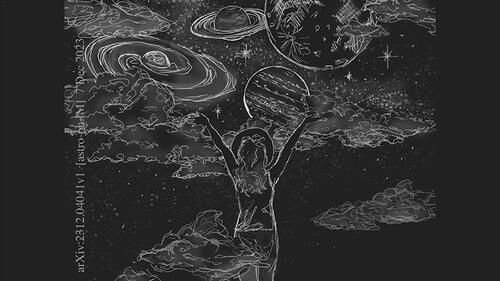
Several current and alumni members of the Yale Astronomy and Physics departments, including members of Yale’s Wright Lab, have contributed to a book, currently available on the arXiv, called “Astronomy as a Field: A Guide for Aspiring Astrophysicists”.
According to the abstract, this book was “created as part of the SIRIUS B VERGE program to orient students to astrophysics as a broad field, … [and] this document is written by women in astronomy for girls who are looking to pursue the field. However, given its universal nature, the material covered in this guide is useful for anyone interested in pursuing astrophysics professionally.”
The 2023-2024 VERGE program and the book printing have been funded by the Women and Girls in Astronomy Program via the International Astronomical Union’s North American Regional Office of Astronomy for Development and the Heising-Simons Foundation.
Chiara Mingarella, assistant professor in physics, said, “Congratulations to the numerous members of the Departments of Physics and Astronomy who contributed to this book. . . [I am] thrilled that this book is now on the arXiv and being enjoyed by aspiring astrophysicists all over the world.”
Congratulations to the following Yale affiliates who contributed to various sections of the document.
Organizer
Ava Polzin, Ph.D. candidate in astronomy & astrophysics at the University of Chicago. Her work focuses on understanding star formation and the baryon cycle in the smallest dwarf galaxies. Polzin began her graduate work in the astronomy department at Yale, and also was a member of Yale’s Wright Lab.
Polzin received a mini-grant from the International Astronomical Union’s North American Regional Office of Astronomy for Development and the Heising- Simons Foundation that, along with the contributions of more than thirty women who are committed to encouraging girls in their pursuit of astrophysics, went a long way towards making the printing of these booklets possible.
This effort is the culmination of years of Polzin’s work toward making science more equitable and accessible (see siriusb.org for recent details). In addition, in January 2024 she will be running the synchronous VERGE program, for which this guide was created, with involvement and presentations from some of the women who contributed to this guide.
Section Authors
Yasmeen Asali, Ph.D. candidate in astronomy. Her work focuses on understanding how star formation evolves in low mass galaxies and how a galaxy’s environment can impact this evolution. She is interested in the intersection of data science and astronomy, and passionate about teaching.
Sanah Bhimani, Ph.D. candidate in physics, and a member of Yale’s Wright Lab. She works on CMB experiments like the Simons Observatory. Sanah and her rescue dog Etta enjoy walking around New Haven’s East Rock neighborhood.
Emma Louden, Ph.D. candidate in physics. She studies the geometry of exoplanetary systems. Emma is passionate about a future-focused strategy for astrophysics, engaging the public with space exploration, and applying evidence-based solutions to solve the world’s most pressing problems. She is a 2018 Brooke Owens Fellow and a 2023 Quad Fellow.
Samantha Pagan, Ph.D. candidate in physics, and a member of Yale’s Wright Lab. She researches dark matter and neutrinos to explore questions such as why our universe is made of matter.
Malena Rice, Ph.D. in Astronomy, 2022, currently an assistant professor in astronomy at Yale. Her research focuses on understanding the diversity of planetary systems, drawing together insights from both exoplanet systems and the solar system. Her recent work has focused on characterizing exoplanet orbital architectures and the distant solar system.
Zili Xhen, Ph.D. candidate in astronomy. She uses the Keck Observatory and the Hubble Space Telescope to observe faint galaxies. She works on discovering the biggest and most diffuse galaxies in our cosmic neighborhood.
Luna Zagorac, Ph.D. in physics, 2022, currently a postdoctoral fellow at the Perimeter Institute for Theoretical Physics. She is a cosmologist through and through: passionate not just about what our silly little Universe is up to, but also about all the ways we as humans interact with it and understand it. When not thinking about dark matter, inflation, and other parts of our invisible Universe, she is using data science to understand astronomical and observational practices in ancient Egypt; roller skating; reading; or playing video games.
Advice for Students
Priyamvada Natarajan, Joseph S. and Sophia S. Fruton Professor of Astronomy and Physics. Her research work is focused on understanding the nature of the invisible Universe, namely, black holes, dark matter and dark energy.
Erica Nelson, Ph.D. in Astronomy, 2016, currently an astrophysicist and assistant professor in the Department of Astrophysical and Planetary Sciences at the University of Colorado, Boulder. She is obsessed with data on the first galaxies from the newly launched JWST and loves discovering new things about our weird and wonderful universe.
Katherine E. Whitaker, Ph.D. in Astronomy, 2012, currently an associate professor of astronomy at the University of Massachusetts Amherst, as well as associate faculty at the Cosmic Dawn Center of Excellence in Copenhagen, Denmark. Her research involves understanding how the most massive galaxies evolve over billions of years of cosmic time using big telescopes in space.

